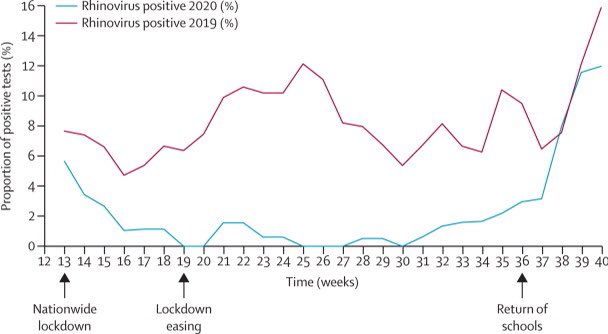
(1/5) Study showing that school closures were associated with a marked reduction in the common cold in adults in the UK.
When schools reopened, rhinovirus detections surged. Physical distancing measures in schools are inadequate to prevent transmission.
thelancet.com/journals/lanre…
When schools reopened, rhinovirus detections surged. Physical distancing measures in schools are inadequate to prevent transmission.
thelancet.com/journals/lanre…

(2/5) In this study, patients admitted to hospital between March and September 2020 in Southampton were screened for rhinovirus.
The results were compared against data for 2019.
There was a marked decrease in rhinovirus in 2020, which was associated with school closures.
The results were compared against data for 2019.
There was a marked decrease in rhinovirus in 2020, which was associated with school closures.
(3/5) When schools reopened, rhinovirus infections in adults increased, and became comparable to the previous year.
This suggests children are a major driver of the common cold, and that #COVID19 precautions in schools are inadequate to prevent transmission of rhinovirus.
This suggests children are a major driver of the common cold, and that #COVID19 precautions in schools are inadequate to prevent transmission of rhinovirus.
(4/5) Rhinovirus and coronavirus transmission dynamics are different.
However, it could still suggest that precautions in schools will also be inadequate to prevent transmission of #SARSCoV2 by children, and that schools will amplify the #COVID19 pandemic unless action is taken.
However, it could still suggest that precautions in schools will also be inadequate to prevent transmission of #SARSCoV2 by children, and that schools will amplify the #COVID19 pandemic unless action is taken.
(5/5) Such action should include the wearing of face masks by staff and students (including primary school students), physical distancing (including reducing class sizes), increasing ventilation, and practicing hand hygiene.
https://twitter.com/drzoehyde/status/1287774646847156232?s=21
• • •
Missing some Tweet in this thread? You can try to
force a refresh







